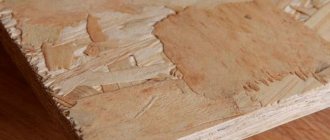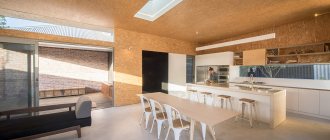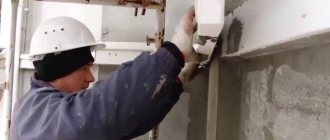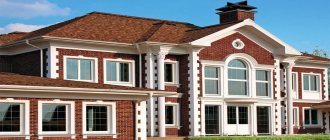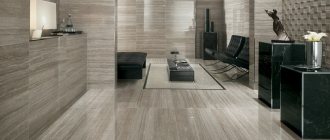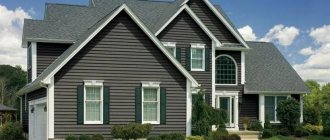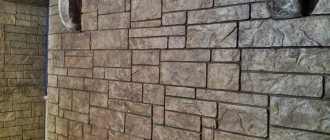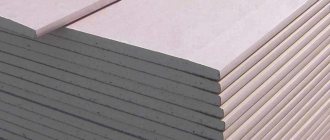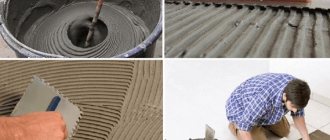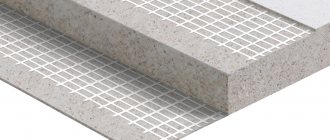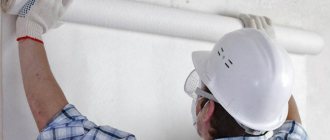Cement particle boards (CPB) are a whole class of building materials with different characteristics.
They are used for various purposes, using the advantages that they have over traditional finishing and structural materials.
The scope of application directly depends on the type and density of the DSP, so we recommend that you read the articles:
- Cement particle boards: properties and characteristics, areas of application, reviews from builders and home owners.
- Production of CBPB: step-by-step guide, regulatory documents and necessary equipment.
- Fibrolite.
In these articles, we talked about the different types of cement bonded particle boards, as well as the differences in the original components and their proportions.
Even with the same density, the basic parameters of TsSP-1 and TsSP-2 boards are very different from fiberboard boards of any type. This is due to different amounts of cement, as well as different requirements for wood filler .
Next we will tell you:
- what can DSP be used for?
- how to choose materials for a particular application;
- what are the advantages of properly selected slabs over other materials;
- how to attach panels to walls or to a wooden floor, how to saw them, glue them together, prime them, and how to process DSP differently;
- how to lay tiles on DSP;
- how to paint the facade of a building on which DSPs are installed, and how to protect this material from moisture and other negative factors.
What can slabs and panels be used for?
Here are the main areas in which cement bonded particle boards can be used:
- structural elements (walls and partitions);
- insulation of walls, floors and ceilings;
- soundproofing;
- external and internal finishing;
- permanent insulating formwork;
- creation of greenhouses, beds and other areas.
Structural elements
From DSP you can create various partitions that divide the room into separate zones or parts.
Due to their high rigidity and strength, slabs in this area are not inferior to such materials as:
- wooden plank;
- plywood;
- OSB;
- LSU;
- GKL.
However, for creating partitions and walls using technology without a load-bearing frame, only cement-bonded particle boards with a density of over 1000 kg/m3 are suitable, and the best results are shown by TsSP-1 and TsSP-2.
Fiberboard slabs with equal density are less durable, because they contain less cement.
However, it will not be possible to make full-fledged large walls from this material due to the size of the sheet, because the maximum width does not exceed 125 cm, so the sheets will have to be stacked on top of each other.
Therefore, to create full walls and large partitions, a load-bearing frame is required , but the same limitation applies to other structural elements of comparable size.
The exception is cases when it is possible to place cement-bonded particle boards vertically and securely fasten them at the top and bottom.
Moreover, such a wall will perform only a decorative function and is not designed to withstand any kind of force.
With a slab thickness of 30–50 mm, a door or arched opening can be embedded into a wall of such a structure, the main thing is that its width does not exceed 1.5 times the width of the DSP slab.
If the width of the area that needs to be partitioned does not exceed the width of one sheet, and no force is applied to it, then a material with a thickness of 10–15 mm can be used (when using fiberboard boards, the thickness must be increased to 20 mm).
At the same time, compared to other structural materials of the same thickness, DSP will provide a much higher level of noise and heat insulation .
Insulation for house facades and walls, floors, ceilings
To insulate a house, you can either use DSP inside or cover the façade of the house with this material. As insulation, it is better to use cement-bonded particle boards of any type with a density of 250–350 kg/m3 , however, fiberboard is more effective due to the smaller amount of cement.
Despite the low density, the strength of sheets of any thickness is sufficient to be attached to the wall either with glue or with anchor nails.
DSP is somewhat less efficient compared to polystyrene foam (thermal conductivity of boards is 0.06, polystyrene foam is 0.04), but they freely allow water vapor to pass through, thanks to which
a favorable dry climate is always maintained in the premises .
DSP is only slightly inferior to mineral wool (the thermal conductivity of slabs with a density of 300 kg/m3 is 0.06, and that of wool is 0.05), but an increase in humidity does not affect their characteristics.
In addition, they can be installed on flat surfaces without a special frame, and to protect them from precipitation, a thin layer of plaster or even waterproof, vapor-permeable paint is sufficient.
Despite the fact that polyurethane foam is easier to apply, working with it requires expensive, highly specialized equipment, the price of which starts from 40 thousand rubles.
In addition, polyurethane foam does not allow water vapor to pass through at all , so after insulation with it, in houses with a not very good ventilation system, the climate becomes more damp, and mold and rot also appear.
The costs for working with any type of DSP are much lower, and the equipment can be used for many other jobs.
When insulating ceilings, cement particle boards are hemmed from below using glue and anchor nails or self-tapping screws. However, this method of application can only be used in houses and apartments with durable floors and reliable ceiling lining.
Fiberboard boards with a density of 250–350 kg/m3 are best suited for this work, because they contain more wood than products of the TsSP-1 and TsSP-2 brands. The maximum thickness of the slabs depends on the strength of the floor and the ability to securely attach the insulation to it.
Using this material, it is possible to completely construct and install the roof of a house, as well as build the entire house as a whole.
To insulate the floor, the slabs are laid either on a concrete screed or on a rough flooring.
If the base is not too level, then to level the floor it is advisable to pour a layer of mortar , this will allow you to maximize the potential of the DSP.
After all, all materials of this type, manufactured according to GOST or international standards, are the same in thickness and have a smooth surface.
Thanks to this, it will be possible to lay parquet, laminate or linoleum on them without an additional layer . The optimal density of material such as TsSP-1 and TsSP-2 is 500 kg/m3, the optimal density of fiberboard is 800–900 kg/m3.
Quite often, the technique of laying CBPB on the floor over wooden logs is used, and the thickness and density of the slabs required to ensure the strength of the floor in the house, in this case, will depend on the distance between the installed logs.
Laying DSP on the floor, including wood, under tiles is an ideal option in bathrooms.
To begin the installation of tiles, it is enough to apply a couple of layers of regular primer to the cement-bonded particle boards to improve adhesion .
If it is necessary to insulate the base of a heated floor, including if it is mounted under tiles, then the density of the sheets depends on its design. If the heating element is immured in the screed, then it is advisable to use slabs with a density of 300 kg/m3 .
If the heating element is laid between wooden or aluminum supports, then it is advisable to use a material of the same density as for a regular floor.
When insulating the floor with cement-bonded particle boards, it is necessary to ensure reliable waterproofing, since water that gets under the front covering will be absorbed into the insulation, but will have difficulty coming back due to poor air exchange.
A long stay in a state of high humidity will reduce the strength of the cement-bonded particle board and lead to the appearance of mold and rot in the chips, which will negatively affect its thermal insulation properties.
Soundproofing
Residents of Soviet-built multi-storey buildings suffer greatly from poor sound insulation, because in the apartments you can hear everything that happens at a distance of several floors. Often, even residents of private houses are looking for ways to improve sound insulation in order to reduce the level of noise entering the rooms from the street.
Low-density cement-bonded particle boards, although they are inferior to many modern materials with the same thickness, are very popular due to their minimal cost and ease of installation on walls, floors, etc.
The most effective in this area are fiberboard boards of the GB-1 standard and their magnesite analogues.
The maximum soundproofing effect is achieved not only by increasing the proportion of wood waste, but also by the shape of the wood wool shavings located along the slab. However, TsSP-1 and TsSP-2 slabs with a density of 250–350 kg/m3 are also well suited for reducing noise levels .
To increase the soundproofing effect,
a layer of felt 2–6 mm thick should be laid .
We recommend not using materials based on polyurethane, rubber or polyethylene as gaskets, because they interfere with the circulation of water vapor and negatively affect the ceiling lining.
By covering the ceiling with slabs 2–3 cm thick and laying felt, you will reduce the level of penetrating into the apartment tens of times . In this case, it is important to join the slabs tightly so that there are no gaps between them, otherwise the effectiveness of such sound insulation will sharply decrease.
For exterior work and interior decoration
The purpose of exterior and interior decoration is to hide wall defects and make the exterior or interior more attractive. All types of DSP are well suited for rough finishing, over which a fine finish can be applied.
Cement particle boards of any type have high strength, but a material with a density of less than 700 kg/m3 cannot be used for exterior finishing, and less than 1000 kg/m3 for interior finishing.
As the density increases, the rigidity and strength of the product increase, which is especially important in regions with frequent strong winds.
The interior finishing material must withstand a screw driven in with a small load , so the use of low-density cement-bonded particle boards for interior decoration is unjustified.
In most cases, this finishing material must be attached to a special frame that compensates for the unevenness of the walls. In addition, the frame ensures air movement under the finish, due to which condensation on the wall evaporates faster and does not lead to an increase in humidity of the wall or finish.
If the frame is made correctly, then after installing the slabs they form a flat surface, so it is enough to fill the seams between them with mortar or putty, after which
the walls are ready for finishing .
The most effective finishing materials are TsSP-1 type slabs with a polished surface.
They contain more cement than fiber-reinforced concrete products, and are also manufactured with greater precision than TsSP-2.
They are attached to the frame using appropriate self-tapping screws - wooden blocks require wood-carved screws, aluminum or steel profiles require metal-threaded screws.
As an interior decoration, sheets based on chip concrete have a significant advantage - they do not emit toxic substances , which cannot be said about:
- GKL;
- plywood;
- OSB;
- chipboard;
- plastic;
- Fiberboard.
The only materials that can significantly compete in terms of environmental safety are natural boards and real MDF, made without the use of glue.
However, they have serious disadvantages compared to cement bonded particle boards:
- less rigidity, forcing an increase in the thickness of the finish;
- much higher flammability;
- higher price.
Therefore, as an environmentally friendly material for interior decoration, all types of fiber boards have no equal in terms of the totality of all parameters .
They:
- do not emit toxic substances in normal conditions;
- able to withstand high temperatures for a long time before the process of pyrolysis in sawdust begins;
- do not support combustion and go out after the source of open fire disappears;
- even during a fire they do not emit toxic substances, with the exception of carbon monoxide and carbon dioxide, but these substances are released during combustion by any organic matter;
- albeit insignificantly, they perform the functions of insulation and sound insulation.
For the exterior decoration of the facade of a house, the most popular are cement-bonded particle boards and panels of the TsSP-1 type with a density of 1100–1400 kg/m3 and a thickness of 1 cm.
With the correct selection of the distance between the frame slats, such exterior decoration of the house can easily withstand wind speeds of 40–50 m/s . An example of finishing the facade of a house is shown in the photo below.
Fiber cement boards of the same density must be chosen with a greater thickness due to the lower cement content, so most often for external work a material with a thickness of 15–20 mm is used. It has the same resistance to precipitation and wind load.
Between the wall of the house and the finishing, you can install insulation made of shavings and cement, which has excellent reviews, or other material.
Due to the fact that during rain, water quickly drains from the surface of the façade cladding panels, the slabs do not have time to absorb much water, so even in the event of a sharp drop in temperature after prolonged rain, they will not suffer severe damage.
Treatment with hydrophobic paints for exterior use and preparations that do not affect vapor permeability further reduces the material’s ability to absorb water.
Thanks to this, any type of DSP as an exterior finish is in no way inferior to traditional plaster.
Thanks to these properties of the material, the ease of its finishing (painting), as well as numerous reviews from residents, cladding the facade of a house with DSP can easily be called the best option for the climatic conditions of many regions of Russia.
In addition, manufacturers also produce facade panels that do not require additional finishing for cladding houses, including wooden frame ones, which
simultaneously perform a decorative function.
For example, façade and plinth panels to look like stone, like brick, like crumbs and others.
These façade panels are used to finish the foundation of a house, the basement, including those on screw piles.
Do-it-yourself permanent insulating formwork
The construction of houses from monolithic concrete is gaining increasing popularity because it allows you to build walls much faster than any other methods.
Permanent formwork not only creates a form for concrete, but also performs an insulating function , so that after the concrete gains full strength, the wall is completely ready for finishing and does not require additional insulation.
The only competitor to cement-bonded particle boards in this application is permanent formwork made of expanded polystyrene (EPS), but it completely blocks the vapor permeability of the walls, which is why problems begin in houses with a not very good ventilation system.
Unlike polystyrene formwork, which is supplied in the form of ready-made small blocks, formwork made from cement-bonded particle boards must be made independently .
As in the case of EPS formwork, DSP formwork must be carefully reinforced with numerous bridges to avoid squeezing out the slab with concrete.
This is especially true in the case of using heavy concrete, but it will not be superfluous when pouring foam concrete.
In addition, it is necessary to strengthen the formwork over the entire area with various pegs and spacers , which will protect it from shifting during filling with concrete and its compaction .
For the manufacture of formwork, it is advisable to use sheets with a density of over 1000 kg/m3 , and the thickness of the sheet directly depends on the desired thermal insulation effect.
Therefore, sometimes they make double formwork - they install an inner sheet of fiberboard with a density of 1200–1400 kg/m3 and a thickness of 10 mm, and a sheet of fiberboard with a thickness of 50–100 mm and a density of 300 kg/m3 is placed close to it.
When using foam concrete, such a design will ensure such a low level of heat loss that even in the northern regions no additional insulation will be required .
However, permanent formwork made from CSP also has a disadvantage - it cannot be used below soil level , since under the influence of groundwater the wood will eventually lose its thermal insulation properties and the cement stone will collapse.
But as a formwork for internal walls, DSP has no equal, because after the concrete has hardened, the wall surface is ready for finishing, and even has a small, but heat- and sound-proofing effect.
Greenhouses and beds
Cement particle boards, even when buried in the ground, can last for several decades before being destroyed, which is why they are often used to create or fence greenhouses and beds with your own hands. After all, boards without special treatment will rot into dust in 3–5 years, and DSP will last 20–40 years without requiring replacement.
Most often, slabs
with a density of over 1000 kg/m3 and a thickness of 8–12 mm .
Another advantage of cement-bonded particle boards is that greenhouses and garden bed fencing made from CSP look very neat thanks to the smooth walls.
The same effect is created by the carriage board, but its service life and high price do not allow it to compete with CBPB.
Chipboard, plywood and other similar materials also cannot compete with these boards, because even those that are called waterproof quickly collapse once they are in the ground.
If the height of the walls is small, you can do without a frame by connecting the slabs together using plastic corners, but if the height or length of the structure requires the use of several slabs, you cannot do without a frame.
As a frame, you can use either boards impregnated with hydrophobic compounds (such compounds spoil the soil) or structures based on large-diameter polypropylene pipes .
If the diameter of the pipe exceeds 30 mm, and the design of the frame is well thought out, then the greenhouse or bed turns out to be quite strong.
You can reduce the diameter of the pipes by inserting pieces of metal or fiberglass reinforcement into them, but in this case you will have to use short jumpers .
Due to the fact that the cost of a sheet rarely falls below 500 rubles, many people prefer used cement particle boards that were dismantled during repairs.
Such CBPBs do not have a very good appearance, and their strength is much less than new ones, but they are quite in demand for fencing beds and creating greenhouses, as can be concluded from numerous reviews from gardeners. Moreover, you can buy them very cheaply or get them for free.
In addition to the listed areas of application, DSP, due to its properties and affordable cost, is also used to build bathhouses with your own hands, including floors in it, lining garages, sheds, building fences, mounted on roofs, etc.
Installation technology
A significant disadvantage of the material is its significant weight, so before starting work, the condition of the foundation is assessed. If necessary, it is further strengthened. It is recommended to highlight the basement area against the general background of the façade cladding.
Lathing installation and insulation
To create the frame, timber or profiles are used, the method is selected based on the specific situation. The first type is more suitable for log houses, the second - for brick, concrete or similar surfaces.
Wooden structure
The process begins with the preparation of the racks: they are treated with special protective compounds that prevent rotting and fire.
The parts must be secured in the following order:
- The frame elements are dried and the surface is marked. To do this, the optimal step for placing parts is determined, the standard value is 50–60 cm. This distance allows you to lay thermal insulation.
Metal sheathing
Installation of such a frame occurs a little differently:
- The base is being prepared and markings are being made.
- Hanging brackets are placed along the existing lines and fixed in increments of 35–45 cm with self-tapping screws and dowels.
- Rows of insulation are laid. It can be penoplex or stone wool. The material is pinned onto structural elements and additionally attached to the walls.
The convenience of the method lies in the fact that there is no need to erect a counter-lattice, since the thermal insulation is not lined flush with the external elements.
Fastening panels
To sheath a house, the slabs are initially cut to the required size. For these purposes, a grinder with a concrete attachment is used. Drilling is carried out according to the location of the frame parts.
- The façade material is carried along the edges with a slight slope. This will allow you to immediately install the element in place.
- A lath is laid along the upper section of the plinth. It must have the thickness of the required gap.
Particular attention is paid to the window opening: additional frame elements are installed below, above and along the perimeter.
Sealing seams
The undeniable advantage of DSP is its low level of moisture absorption, but every open seam is a threat of its penetration inside.
The easiest way to seal joints is to apply sealant evenly. The composition is packaged in tubes, so you will need a construction gun. This option is especially relevant if the area will be covered with molding. The fact is that even the most elastic material will become covered with cracks over time at the points of contact with the slab.
Laying polymer putty is a more stable method; if repairs are necessary, finishing the damaged area will be much easier. The seam is treated with a primer and sealed; reinforcing tape can be laid on top if the base is to be plastered.
A suitable solution is selected based on the design features.
Fixation points are also sealed, especially if the surface is to be painted.
Finishing
Although DSP boards for facades can play an independent decorative role, it is better to use them as a final coating. The resulting surface can be covered with different materials; the easiest way is to apply paint. Any composition is suitable for this.
- The base is cleared of all excess, the places where the putty is placed are sanded.
- Priming is being carried out. You can use concrete contact. Although many people claim good adhesion of such walls, problems can arise, so it is better to apply two layers, waiting for each to dry.
- Painting is carried out with a roller or spray; brushes are used for difficult areas. The mixture is spread evenly until the desired result is obtained.
An excellent decorative effect can be achieved if the main external areas are made in one shade, and the moldings for the joints are contrasting. They can be painted or purchased ready-made.
Processing and installation of sheets
Cement particle board, in its physical characteristics, is very different from most finishing materials, so its processing occurs according to a special algorithm and using a special tool .
Violation of the operating algorithm and the use of the wrong tool often leads to damage to the material and the need to replace it, and given the considerable price of any type of DSP, including, for example, sheets for the floor or slabs for the facade such as brick or tile, this attitude turns out to be extremely unprofitable.
What to cut with?
To cut this material you will need a hand-held circular saw equipped with a disk with carbide (pobedite) tips or diamond-coated teeth.
If there is no such disk, you can use a suitable abrasive cutting disk for stone with a seat diameter of 32 mm.
If you need to cut a sheet or cut a rectangular hole in it, then place it on a flat table so that the cutting line is 2–4 cm away from the edge.
to use a respirator and safety glasses when cutting , and do not forget to fasten the sleeves of your clothes. Place the saw blade on the sheet so that the blade is 3–5 mm away from it.
Turn on the saw, then move it smoothly forward so that the blade follows the cutting line. The speed of the saw depends on the density and thickness of the sheet, so rely on your own feelings.
At normal speed, the sound of the saw engine hardly changes, and resistance to forward movement is minimal .
If the sound changes (the speed drops) or the resistance to movement increases, then you are moving the saw forward too quickly, which is why the blade does not have time to cut the cement stone properly. To reduce the amount of dust and improve the quality of the cut, you can water the sheet along the cutting line.
If the dimensions of the cut piece exceed 20 cm on any side for thin slabs and 10 cm for thick ones, then an assistant must support the cut piece so that it does not break off.
Care must be taken to ensure that your fingers do not get in the path of the saw.
To cut a round or oval hole, you must first draw it on a sheet of paper, then write a rectangle into it. Moreover, the distance from the drawing to the edge of the rectangle should never be less than 3 cm.
If you know how to cut with a circular saw not from the edge of the sheet, then cut out a rectangle with it, but if not, then
use a grinder (angle grinder, angle grinder) with an abrasive disc for stone .
Having cut out a rectangle, on the remaining parts of the slab inside the pattern, mark parallel strips in increments of 1–1.5 cm, running from the edges of the rectangle to the edge of the pattern. Cut these strips 3–5 mm short of the edge of the pattern.
Then cut the sheet according to the design using a jigsaw equipped with a diamond blade designed for cutting glass or ceramics.
This sequence of actions increases the time required to cut a hole, but greatly reduces the chances that you will ruin the material. After all, when cutting a hole with a diameter of over 40 cm, there is a possibility that the cut piece will break off, and the fracture line will affect the remaining sheet.
If you are a skilled, experienced finisher and therefore know how to work well with materials such as:
- ceramic tile;
- chipboard;
- LSU;
- OSB;
- smooth slate,
then you can cut or saw oriented strand board than you are used to, because the behavior of these materials when cutting is very similar to the behavior of OSB of any type.
Drilling
To drill any holes, it is advisable to use metal drills tipped with hard alloys (do not confuse them with Pobedit drills for concrete).
During drilling, the drill should operate at low or medium speeds (1–1.5 thousand revolutions per minute), and the pressure on it should not exceed 1 kg.
If you need to drill several holes, then after drilling one, let the drill cool for 15-30 seconds . Do not switch the drill to hammer drill mode, this will not speed up the drilling process, but will weaken the cement stone around the hole.
Fastening
For fastening cement-bonded particle boards, including on building facades, the following is used:
- self-tapping screws;
- anchor screws (dowel-nails);
- rivets.
Self-tapping screws are well suited for attaching DSP to a wooden or metal base .
If you only have ordinary hardened self-tapping screws, then you need to drill a hole in the slab for them, and also countersink the space for the head. Without this, the cap will protrude above the surface of the slab, which will create great difficulties during finishing.
Without drilling, you can screw in reinforced self-tapping screws, the heads of which are equipped with knives and cut a hole for themselves . The diameter of the hole for a regular self-tapping screw is equal to 1.2 times the diameter of the screw itself, and the diameter and depth of the hole for the head are 1.5 times larger than the size of the head.
It is not advisable to use ordinary screws for fixation, because they do not have the required strength, so with their help you will not be able to properly tighten the slab to the base.
After installing the screws, the holes for the caps must be sealed with putty, and after drying, treat it with sandpaper.
Anchor screws are used in cases where the panel needs to be attached to a concrete or wooden wall . To do this, place the plate in place and drill a hole for the plastic dowel. For fastening low-density slabs (300–500 kg/m3), it is advisable to use dowels with large heads for more effective fixation .
Such caps distribute the pressure created by the dowel-nail over a large area, so that the cement stone does not receive damage. In high-density slabs (over 700 kg/m3), everything is done in the same way as when fixing with self-tapping screws.
Rivets are used
for quick fixation to steel or aluminum profiles , where for some reason it is impossible to use self-tapping screws.
To do this, the sheet is put in place, then a hole is drilled, the diameter of which is 1.2 times larger than the diameter of the rivet.
After this, you need to use a special cutter to select a mounting hole for the rivet head.
If this is not done, the cap will protrude above the surface of the slab. It is also impossible to use a regular drill instead of a cutter, because the cutter makes a hole with a flat bottom , to which the head will be pressed tightly, and the drill makes a conical hole.
The cap will not be able to press evenly against such a hole, so over time the fastening will weaken and the plate will begin to dangle. If there is no cutter, it is better to leave the rivet heads outside; they can be covered with a thin layer of plaster. This will be better than using a drill.
Criteria for choosing cement bonded particle boards
Maintaining the original qualities throughout the entire period of operation is possible when using a material that is suitable in all respects. DSPs for finishing facades must meet the necessary standard technical characteristics:
- the percentage composition of wood chips should not exceed 24%;
- hydration and mineralizing additives - up to 3%;
- water - 65%;
- cement - 8.5%.
All necessary information can be found in the accompanying certificates and product passport.
During a visual inspection, you need to pay attention to the diagonals of the slab: their permissible difference is no more than 2%. In addition, the slab must have clear right angles. Delamination of the material along its thickness is also unacceptable.
Finishing
The front surface of any cement bonded particle board is very smooth, so after covering the walls of a house with this material, it is enough to carry out only the final finishing.
To do this, first carefully putty the seams, trying not to stain the slabs too much. Then, when the putty dries, the joints and seams are cleaned with sandpaper .
After this, wallpaper is pasted, painted or any other finishing option is performed.
To apply wallpaper, use an adhesive that is suitable for the selected type of wallpaper and suitable for brick or concrete surfaces. For laying ceramic tiles, only cement-based adhesive , because it has the same thermal expansion as DSP, so it will not crack due to temperature changes .
During the work, the glue is dosed with a special notched spatula.
If you decide to paint the walls, then use any vapor-permeable paints and varnishes suitable for painting brick or concrete surfaces.
DSP facade for siding
Judging by the reports of portal users, such a facade based on DSP is also popular.
But, having chosen this option, you should prepare in advance for a large amount of work on cutting cement-bonded particle boards.
I like DSP, but I decided to do something more original and cut the slabs into “boards” using a circular saw, and then install them like siding.
After installing the facade, the user plans to prime it and paint it with acrylic paint.
If you paint the “siding” in advance as the façade is being covered, then it will be difficult to choose the same color on different walls.
So far it turned out like this.
I thought for a long time about how to decorate a large area of the facade of my frame house. The tree disappears because it is too exposed to negative weather factors. Then I turned my attention to fiber cement siding. The material is interesting, but I have to pay the entire amount for it right away - about 300 thousand rubles. If I make a mistake in the quantity + allowance for framing corners, cornice boards, platbands, etc., then I’ll have to buy more later. Take it immediately with a reserve - what to do with the surplus later, and this is an extra expense. Well, the color that I liked has already been discontinued.
In addition, when sawing fiber cement siding, you may end up with chips and scratches that will have to be painted over with expensive paint. You also get expensive scraps (the price of fiber cement siding in 2015 was about 930 rubles per 1 sq. m versus 200 rubles for DSP), which then, unlike DSP, cannot be put into use. Another argument that weighed in favor of cement-bonded particle boards was that the width of fiber cement siding was 19 cm, and the user wanted “boards” on the facade about 31 cm wide. This reduces the number of horizontal planks, which means the speed of work increases, installation time is saved and the expenses.
As a result, the user loosened the slabs using a circular saw, onto which he placed a diamond blade from a grinder through an adapter ring (since these tools have different mounting diameters for saw blades).
I bought a 1 cm thick DSP with dimensions of 1250x3200 mm. I unrolled the slabs into 4 strips, about 30 cm wide, attached them to the sheathing and painted them in place. The façade fully justified itself; nothing fell off during use, and the paint did not peel off.
At the end of the article, we will present the economic benefits of such a facade, which were calculated by Yegor Shilov. So, the cost of making homemade siding from DSP , which included: the cost of the slabs + their sawing + painting, including the purchase of paint - 480 rubles. for 1 sq. m.
Let us remind you that fiber cement siding cost 930 rubles. for 1 sq. m. The total difference was 450 rubles. The area of the façade of the house is about 300 sq. m. m. The total savings were 135 thousand rubles.
You can learn all about facades based on cement bonded particle boards in the topic: facades made of cement-bonded particleboard, fastening, processing and finishing.
We recommend articles on the topic: finishing the facade of a stone house with concrete “brick” tiles, how to properly install flexible tiles on the facade and finishing an aerated concrete house with porcelain stoneware.
The video shows an example of the correct installation of a “wet facade” on polystyrene foam.
Conclusion
Cement particle board is a modern finishing material, but it is most effective only when used correctly.
After reading the article, you learned:
- what is DSP used for?
- how this material is cut and drilled;
- how slabs are attached to various surfaces;
- is it possible to lay tiles on DSP, and how to glue them;
- Is it possible to use this material in a steam room, including for installing a floor in a bathhouse?
- what types of finishes are applied to the walls of a frame house sheathed with DSP.
DSP facade for siding
Judging by the reports of portal users, such a facade based on DSP is also popular.
But, having chosen this option, you should prepare in advance for a large amount of work on cutting cement-bonded particle boards.
I like DSP, but I decided to do something more original and cut the slabs into “boards” using a circular saw, and then install them like siding.
After installing the facade, the user plans to prime it and paint it with acrylic paint.
If you paint the “siding” in advance as the façade is being covered, then it will be difficult to choose the same color on different walls.
So far it turned out like this.
I thought for a long time about how to decorate a large area of the facade of my frame house. The tree disappears because it is too exposed to negative weather factors. Then I turned my attention to fiber cement siding. The material is interesting, but I have to pay the entire amount for it right away - about 300 thousand rubles. If I make a mistake in the quantity + allowance for framing corners, cornice boards, platbands, etc., then I’ll have to buy more later. Take it immediately with a reserve - what to do with the surplus later, and this is an extra expense. Well, the color that I liked has already been discontinued.
In addition, when sawing fiber cement siding, you may end up with chips and scratches that will have to be painted over with expensive paint. You also get expensive scraps (the price of fiber cement siding in 2015 was about 930 rubles per 1 sq. m versus 200 rubles for DSP), which then, unlike DSP, cannot be put into use. Another argument that weighed in favor of cement-bonded particle boards was that the width of fiber cement siding was 19 cm, and the user wanted “boards” on the facade about 31 cm wide. This reduces the number of horizontal planks, which means the speed of work increases, installation time is saved and the expenses.
As a result, the user loosened the slabs using a circular saw, onto which he placed a diamond blade from a grinder through an adapter ring (since these tools have different mounting diameters for saw blades).
I bought a 1 cm thick DSP with dimensions of 1250x3200 mm. I unrolled the slabs into 4 strips, about 30 cm wide, attached them to the sheathing and painted them in place. The façade fully justified itself; nothing fell off during use, and the paint did not peel off.
At the end of the article, we will present the economic benefits of such a facade, which were calculated by Yegor Shilov. So, the cost of making homemade siding from DSP , which included: the cost of the slabs + their sawing + painting, including the purchase of paint - 480 rubles. for 1 sq. m.
Let us remind you that fiber cement siding cost 930 rubles. for 1 sq. m. The total difference was 450 rubles. The area of the façade of the house is about 300 sq. m. m. The total savings were 135 thousand rubles.
You can learn all about facades based on cement bonded particle boards in the topic: facades made of cement-bonded particleboard, fastening, processing and finishing.
Preparation of cement bonded particle boards for installation
DSPs are sold ready-made and do not require preliminary preparation. Before starting finishing work, you only need to cut them according to the required dimensions. A grinder or circular saw is suitable for sawing. If cutting results in uneven edges, you need to sand them with a sanding machine.
Most often, self-tapping screws are used to attach the slabs to the sheathing elements, so you will need to drill holes of the appropriate diameter on the cut slabs. To do this, use a drill with a smaller diameter than a 0.5 mm self-tapping screw.
The diameter of the screw should be from 3 to 6 mm. The optimal distance between fasteners is from 20 to 40 cm.
Some features of the material
The façade made of CBPB has distinctive features that are associated with the structure, as well as the production technology of CBPB boards. The size of the building material (3200×1250 and 2600×1250) contributes to the high-quality finishing of large areas, which sets them apart compared to previously widely used board coverings.
Finishing the facade with DSP creates an aesthetic appearance and protects the building from various negative environmental influences. Installation of the material contributes to the formation of waterproofing and thermal insulation properties and does not allow wind to get inside. Such panels for the facade are a sheet of gray color with a hard and even coating.
If a building is sheathed with a DSP, the result is a perfectly smooth coating - it can be trimmed with decorative elements or painted. Manufacturers also produce decorative panels of CBPB to look like stone, CBPB to look like brick, and CBPB with stone chips of different colors.
The slabs are produced in a special way. During the manufacturing process, the mixture, which includes Portland cement, wood shavings, water and a special chemical additive, is compressed. The slabs are produced with a thickness in the range of 8-36 millimeters, and for the exterior decoration of the building it is necessary to use only slabs with a thickness in the range of 10-20 millimeters.
After the entire technological process has been completed, you will get a fairly durable building material with an even coating and a monolithic structure. In general, the DSP board is considered an ideal finishing method. Convenient processing allows you to give your home an original and attractive look at minimal expense.
Sheathing device for installation of DSP
To attach heavy slabs you will need a reliable base. The sheathing is assembled from timber with a diameter of 50-60 mm or metal profiles. Depending on the material of the walls, self-tapping screws or dowel-nails are used to fasten the sheathing elements.
To make wooden sheathing, you will need dry timber, which is treated with protective impregnations before installation.
The lathing is assembled in a certain sequence. First, install the corner elements. Pull the cord, which will allow the installation of the internal racks in one plane. Next, vertical and horizontal internal elements are installed. The distance between them is no more than 60 cm.
Advantages
Thanks to these and many other advantages, the DSP facade panel is one of the most popular options in the interior design of buildings.
The DSP facade board has significant positive properties:
- environmental friendliness, non-toxic;
- due to the increased cement content, the material does not smoke or catch fire;
- are not susceptible to the negative effects of fungi and insects even during high and prolonged climatic humidity;
- increased moisture resistance: even if the slab is in water for 24 hours, it will swell by less than two percent of its original size. Therefore, façade DSP panels are often used on the base of a building;
- able to withstand more than one hundred freezing cycles without loss of quality;
- durable, does not chip, shock-resistant;
- endowed with excellent sound insulation.
Painting CBPB is also not difficult - the created coating does not require labor-intensive finishing work - any paint used for external work together with preparatory priming is suitable for this.
The DSP façade is easy to install and easy to process. Due to the fact that natural stone chips can be applied to the top layer, this makes the material for exterior finishing quite beautiful and modern. Many people are interested in how to cut CBPB? DSP panels are easy to cut, drill, grind and mill. It is necessary to take into account that the composition of the CBPB board contains cement, so the tool used to process the slab will quickly become dull. In this regard, to process such slabs it is necessary to use special tools for cement-based particle board material.
Thus, DSP for external work in the form of finishing buildings can be used in all climatic conditions, since such boards are characterized by excellent frost resistance.
You might be interested in reading an article about other types of facade slabs.
